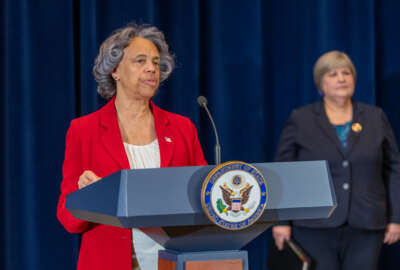Hubbard Radio Washington DC, LLC. All rights reserved. This website is not intended for users located within the European Economic Area.
CDC, once largely remote, balances return to office with a burnt-out workforce
The CDC is now telling most teleworking employees to come into the office at least twice per two-week pay period. But some IT and data employees are exempt.
The Centers for Disease Control and Prevention is reining in full-time remote work for many of its employees.
With the Biden administration setting higher return-to-office targets, the CDC is now telling most teleworking employees to come into the office at least twice each two-week pay period.
The CDC is still carving out exceptions and allowing employees in IT and data science positions to work remotely.
Until recently, the CDC relied on remote work as a free, but effective, way to keep public health workers from looking for other jobs.
Sylana Tramble, director of CDC’s Human Resources Office, said the CDC, in 2023, tripled the number of applicants it saw for job postings, when the agency announced most openings as remote positions.
“When you’re limited to one geographic location, you’re limited to the talent in that location, the demographics of that location,” Tramble said on May 30 at the Professional Services Council’s annual FedHealth conference. “Remote [work] and telework really opened that up. Now we’re, I think, shifting a little bit back to center court on that. We’re looking to see how that will impact.”
The CDC previously supported full-time remote work for large swaths of its workforce.
“Before, you could be 100% remote, even if you lived in the Atlanta area, which is our primary location. Now, if you’re remote in Atlanta, and you’re not in one of these mission-critical occupations, or have some reasonable accommodation, then you’re going to switch from being able to work at home all the time to having to come into the office at least twice a pay period,” Tramble said.
The CDC is carving out some exceptions for in-demand tech positions. Tramble says IT and cybersecurity personnel in 2210 positions, as well as data scientists, are still eligible to work remotely.
“Those are going to be exceptions, for remote purposes. But everyone else will have to shift from remote to a telework status,” she said.
Tramble says that when it comes to workforce flexibility, the CDC is offering a better deal than other federal health agencies.
“There’s other agencies that have a much more, what I consider, rigid approach to that. We’re starting to see where we’re getting applicants from other agencies that are taking a little bit of a harder stance,” she said.
‘A pain point before the pandemic, and it’s gotten worse’
Recruitment and retention remain pain points across the entire health care sector.
“It was a pain point before the pandemic, and it’s gotten worse,” said Elizabeth Kittrie, a senior advisor for the Bureau of Health Workforce at the Health Resources and Services Administration.
Kittrie says 75 million people, or one in four Americans right now, are living in an area with a shortage of primary care providers.
About 122 million, or one out of three Americans, are living somewhere with a shortage of mental health professionals. And one in five Americans are living in an area with a shortage of dentists and dental health professionals.
A study from the de Beaumont Foundation found more than half of state and local public health workers have experienced symptoms of PTSD, and one in three are considering leaving the field.
“This is a problem across government staff,” Kittrie said.
‘I got the same sense there was burnout and PTSD’
Tramble sees those same symptoms of burnout and fatigue in the CDC workforce.
Before joining the CDC, she spent most of her career in the Defense Department, where she’s used to seeing symptoms of PTSD.
“When soldiers and airman and Marines, sailors would come back from deployment — you can just tell. There’s this reintegration. You get to go back to normal, whatever that is,” she said. “This was the first I worked at a non-DoD federal agency where I got the same sense there was burnout and PTSD.”
Tramble said the CDC has seen a “significant increase” in staff using the employee assistance program, as well as a significant increase in reasonable accommodation requests — “which can be either physical or mental accommodations.”
Tramble says this sector-wide issue of burnout also requires agencies to get smarter about workforce engagement.
“This is not just throwing pizza parties and having socials. This is really about connecting to the mission. Feeling like you belong, that you have a support system at work, that can help you navigate some of those things,” Tramble said. “I have been very impressed with the level of effort that the CDC has put into taking care of the workforce after a pretty traumatic two to three years,” she said. “If you have the right support system, you can definitely reach out and touch most folks.”
Tramble says these challenges forced the CDC to take a data-driven look at its workforce needs —now, and in the future.
“We didn’t really have a recruitment strategy, we didn’t have an engagement and retention strategy. We didn’t have this futuristic workforce planning so and we didn’t have the systematic IT infrastructure in place for our workforce to do what I would consider meaningful data analysis,” she said.
“We have spent the last couple of years changing all that. So now we have what I would consider very meaningful data. We’re almost a tip-of-the-spear thing about how we can look at our current workforce, do competency gap analysis across the CDC — just figure out and then really hone it and specialize, where we need to do remote,” Tramble said.
CDC is on the hunt for certain skill sets. Tramble said the agency so far this year has hired 70-80 additional contract specialists.
“It’s very competitive out there, and the federal hiring process is a little dated and kind of cumbersome and painful. And then, once you get the staff on board, it’s really figuring out the best to take care of that stuff — whether that’s through engagement or career development and talent management,” she said.
The CDC is also looking to acquire more experts in data.
“We have to shift with our current workforce and create this agile workforce. Maybe the skills that you came in with were great, but then tomorrow, we’re probably going to need something a little bit different,” Tramble said.
More data expertise will also help the CDC with workforce planning and projecting what the workforce needs to look like in the future
“When you’re in a crisis is not the time to do that — it’s too late. So [it’s] getting ahead of that and having that plan and strategy in place,” Tramble said.
SAMHSA surges in Best Places to Work scores
Morale is improving elsewhere in the federal health care workforce.
The Substance Abuse and Mental Health Services Administration (SAMHSA) addresses behavioral health in the U.S. But it ranked second to last out of all agencies in the 2021 Best Places to Work in the Federal Government scorecard, as tracked by the Partnership for Public Service.
Out of 411 agencies, it ranked at 410.
But things are looking up. This year, SAMHSA scored 77 out of 459 agencies.
“It was a hockey stick-up kind of growth, and our employee strength more than doubled in that same period,” said Chandra Mohan, SAMHSA’s acting chief technology officer. “There’s more people to join in, and more people are satisfied, so to speak, in the job.”
Mohan attributes the higher scores in part to SAMHSA STRONG — which stands for “Supportive, Transparency, Respect, Opportunity, Necessary and Growth.”
“It’s beyond a cute acronym with a lot of platitudes,” he said. “It empowered the employees to have a say in the way many management decisions were taken, and the way some of them felt heard, in how the business was conducted.”
On the tech side of hiring, Mohan says SAMHSA can’t compete with private sector tech salaries.
“From the recruitment side, it’s the same challenge as everyone. We’re not competing with the big tech, we’re not going to offer a quarter-million dollars to college grads by any means, but I think we do offer a good benefits package,” he said.
But tech workers are looking for more than just competitive salaries. Mohan says new research shows Gen Z workers are placing a premium on jobs with purpose and impact, and work-life balance.
“If someone is looking for job fulfillment and mission, I don’t think there is a role that’s better than what we offer here,” Mohan said. “Not everybody wants to put in 70-hour weeks, an up-or-out philosophy that’s there in all consulting firms. SAMHSA offers a great opportunity for new people, and younger people to come in. We are attractive, from that perspective.”
Nearly Useless Factoid
The original incarnation of the CDC was formed in 1943 in response to malaria outbreaks, though it wasn’t called the Center of Disease Control.
Source: cdc.gov
Copyright © 2024 Federal News Network. All rights reserved. This website is not intended for users located within the European Economic Area.
Jory Heckman
Jory Heckman is a reporter at Federal News Network covering U.S. Postal Service, IRS, big data and technology issues.
Follow @jheckmanWFED





